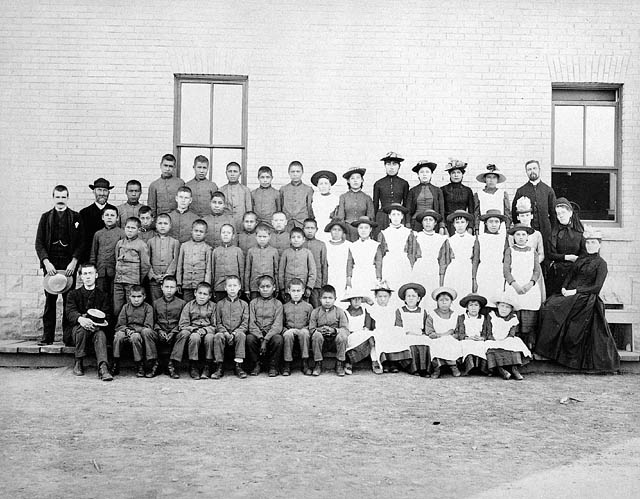You can change the conversation. Chip in to rabble’s donation drive today!
This week, the Canadian Human Rights Tribunal (CHRT) heard from Elder Robert Joseph that there is a connection between residential schools and the large number of Indigenous children in child welfare.
The CHRT continued hearings this week in Ottawa regarding allegations that the Government of Canada is racially discriminating against First Nations children by not providing equitable funding and services to First Nations children and families living on-reserve. The timing of the Tribunal hearings aligns with the release of a report by the Truth and Reconciliation Commission confirming that at least 4000 children died while attending residential schools.
The First Nations Child and Family Caring Society of Canada and the Assembly of First Nations launched the Human Rights complaint in 2007.
On January 13, Joseph, a witness for the Assembly of First Nations, an Elder, a Hereditary Chief of the Gwawaenuk First Nation and a residential school survivor, spoke about his experiences in residential school.
“We have to create a new space, a sacred space. The vision we have for ourselves will play out in the lives of our children. There is nothing more important,” he said as the group of lawyers, Tribunal members and onlookers gathered in a circle for a smudge and prayer before the official proceedings began.
Elder Joseph was then sworn in and gave his testimony that described his experience while attending St. Michael’s Residential School near Alert Bay, British Columbia.
“Everybody on earth has a story to tell,” he began. He told the Tribunal that as a residential school student “no one wanted to listen to our story, so our stories weren’t told. If only we could have told our stories, we might have had a different outcome. We didn’t have a forum like this [the Human Rights Tribunal]. I don’t want my experience just to be remembered as tragic. I want it to be a part of a new era.”
His testimony covered a large span of issues: the location of his community, the Kwagiulth Nation, the community’s traditional cultural values as it related to children and child rearing.
He discussed the numerous traditional ceremonies that were conducted by the community for children to mark, among others, rights of passage, assigning mentors or to initiate a call for additional care. He also recalled when things started to change in his community. He shared stories about the first day and the last day that he went to residential school. While in residential school, he spoke of the deep sense of loneliness that he felt and could never shake, even after he was married and had children.
He shared with the Tribunal his struggles with alcohol addiction, his subsequent recovery and attempts at redemption and reconciliation with his family. In describing his recovery, he expressed that his “biggest fear was that I didn’t belong anywhere.”
Chief Joseph commented on current approaches to child welfare stating, “the community can implement their own solutions if they have the resources to do so. It takes collaboration. You have to be creative, innovative and bold.”
Although not part of this week’s proceedings, Chief Joseph’s testimony is also supported by the First Nations Canadian Incidence Study on Child Abuse and Neglect report Kiskisik Awasisak: Remember the Children.
This report confirmed that Aboriginal children are not only overrepresented in the child welfare system, but that this overrepresentation is a continuation from the residential school era.
The arrival of non-Aboriginal settlers, and subsequent extension of colonial policies into First Nations territories, disrupted traditional systems of child rearing and imposed practices which resulted in the removal of tens of thousands of First Nations children from their homes and communities. The mass removal of First Nations children began with residential school system and was continued by the child welfare system under the policies of the “Sixties Scoop.”
Chief Joseph stated that the connection between the high numbers of Indigenous children in the child welfare system was interrelated to other issues including Indigenous children growing up without knowledge about their family lineage, nation, culture and language, as well as loss of cultural identity, values and worldview. “It was because of the children that we kept the stories alive for so long. We had to repeat the stories and our beliefs to them. That’s how we remembered.”
“We are talking about something that ought not to have happened [residential schools]. They say that many children did not live to benefit from the education that they received. We can’t make the same mistake twice. We can’t afford to keep losing children to loneliness and brokenness. It’s the same kids, they are the parents now, it’s their kids that are being taken away.”
Chief Joseph ended his testimony with a vision of hope: “we are on the cusp of major shift if we get it right,” he said, it is up to all of us to “hold promise for every child born to reach optimal potential.”
The Canadian Human Rights Tribunal will continue hearings in March 2014. Information on where and when can be found on the First Nations Child and Family Caring Society page.
The Aboriginal Peoples Television Network (APTN) is covering the case and previous testimony can be viewed online.
Like this article? Chip in to keep stories like these coming!
Jocelyn Formsma is a member of the Moose Cree First Nation, grew up in Northern Ontario and currently lives in Ottawa, ON. Jocelyn has approximately 13 years of volunteer and work experience in children’s rights, social development and youth engagement. She has a Honours Bachelor of Social Sciences in Public Administration and is currently pursuing her JD (Juris Doctorate) at the University of Ottawa. She is also a film maker, radio show host on CHUO 89.1 FM and one of the Niigaan: In Conversation organizers (www.niigaan.ca).
Photo: wikimedia commons/LAC PA|182251|3354514



